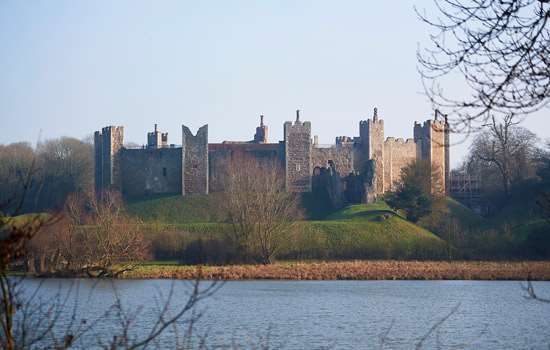Listen to the full interview on the centenary of the Cenotaph on The English Heritage Podcast.
Standing serenely amid the bustling traffic on Whitehall in Westminster, London, the Cenotaph – or ‘empty tomb’ in Greek – has served as a symbol of remembrance, commemorating those who served or lost their lives in times of conflict, for a century. However, its influence permeates far further – through the many other memorials it has since inspired around the world.
The Cenotaph’s simple and sombre design was the creation of Edwin Lutyens, who was commissioned by Prime Minister Lloyd George to design a temporary memorial for the Peace Day parade on 19 July 1919 after he had been inspired by a visit to France.
‘In the summer of 1919, after the treaty of Versailles, the French state organised peace celebrations in Paris and they had the idea of erecting a catafalque [a raised platform or box to support a coffin] in the middle of a major street as a focus for grief,’ explains senior properties historian Dr Steven Brindle. ‘Lloyd George saw this and was deeply impressed, and so he asked Lutyens, the most eminent architect in Britain at the time, to design a catafalque for the Peace Day parade, which was due to be held in London in 1919. Lutyens’ stroke of genius was to see that a catafalque at relatively low level wouldn’t be particularly visible in the context of huge crowds and so his design elevated it on a tall rectangular pier or pylon.’
Hastily constructed out of wood and plaster painted to look like masonry, the resulting monument struck a powerful chord with those who had lost loved ones in the First World War but had no grave to mourn their loss.
Discover the other London monuments under English Heritage’s care.
“Over a million people visited the Cenotaph in the weeks following Peace Day and it was swiftly decided to recreate it as a permanent structure”
‘Over a million people visited the Cenotaph in the weeks following Peace Day and left flowers and wreaths at its base,’ says Dr Lucy Noakes, a professor of modern history at the University of Essex. ‘It was so popular that it was fairly swiftly decided to recreate it as a permanent structure.’
Commissioned to create this second, lasting version of his monument, Lutyens took the opportunity to refine and perfect his design, choosing to construct it out of Portland stone and working to very precise measurements.
‘Lutyens had designed his first temporary monument in quite a hurry and would have been very conscious of the need to provide something perfect,’ says Brindle. ‘He was aware of the principle in classical architecture called entasis, in which columns are slightly bulged in the middle to correct the optical illusion, which comes from the nature of our own vision, that a straight column appears to be slightly concave. And, so, the form of the Cenotaph is slightly tapered in order for it to look perfect.’
Unlike other war memorials, such as the Marble Arch and the Wellington Arch, which were created to celebrate victory in the Napleonic Wars, the Cenotaph was created as a memorial to those who died during the Great War and was remarkable for its absence of any emblems or symbols representing triumph or heroism. Instead, there are just carved wreaths and ribbons, with three flags along each flank, and three words: ‘the glorious dead’.
Lutyens’ design is also purposefully devoid of any religious symbolism, allowing people to project their own meaning onto the empty tomb, regardless of their faith.
Listen to our podcast exploring the English Heritage sites that changed the course of history.
‘One of the striking things about it is that Lutyens, and I think everyone else, realised the need for it to be abstract so it could be a universal symbol,’ adds Brindle. ‘There’s a striking difference between the kind of memorials that were erected in small town and village communities, which were often churchyard memorials with crosses. They’re explicitly Christian because that was felt to be appropriate in the context of the church in the countryside. But there seems to have been an instinctive feeling that Christian symbolism was not appropriate for a big city memorial like the Cenotaph, which was for the Empire as a whole and so needed to be relevant for people of all faiths and none.’
Inaugurated on Armistice Day on 11 November, 1920, the Cenotaph has been the focus of Remembrance Day services on Whitehall ever since, although its role has since expanded to memorialise the dead of the Second World War – denoted by the dates 1939–1945 that were later carved into the stone – and subsequent conflicts.
‘Until the Second World War, Armistice Day was the main point of commemoration on 11 November. After the Second World War that shifted to the Sunday closest to Armistice Day,’ explains Noakes. ‘But the first parade, with the two-minute silence and all the commemoration and ceremony we still have today, was in 1920. That was also the year when the body of the unknown soldier was interned in Westminster Abbey and his funeral procession stopped at the Cenotaph on its way. And then the Cenotaph was unveiled and dedicated on the same day.’
One hundred years since its unveiling by King George V at 11am on 11 November 1920, The Cenotaph remains the focal point of national remembrance – it’s role as relevant as ever. ‘The instinct to commemorate has remained very strong ever since the Cenotaph was erected,’ says Brindle. ‘We all need something to remind us of the sacrifice and terrible loss of those wars and something that stands as a universal symbol for all – and that is still the Cenotaph.’
LISTEN To The PODCAST
A century after the unveiling of the original Cenotaph memorial in London, we were joined on the English Heritage Podcast by senior properties historian Dr Steven Brindle and Dr Lucy Noakes, professor of modern history at the University of Essex to discover its story. Listen on to find out how and why this famous First World War memorial was created for the Peace Day celebrations of 19 July 1919 and how it’s come to inspire the designs of other memorials to conflict all over the world.



